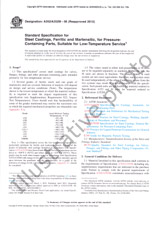We need your consent to use the individual data so that you can see information about your interests, among other things. Click "OK" to give your consent.
ASTM F3415-20
Standard Test Method for Triaxial Shear Strength and Cohesion of Equine Sports Surfaces
Translate name
STANDARD published on 1.1.2020
The information about the standard:
Designation standards: ASTM F3415-20
Publication date standards: 1.1.2020
SKU: NS-982877
The number of pages: 4
Approximate weight : 12 g (0.03 lbs)
Country: American technical standard
Category: Technical standards ASTM
Annotation of standard text ASTM F3415-20 :
Keywords:
deformable solids, dirt, granular solids, shear strength, strain-controlled loading, stress-strain relationships, synthetic, triaxial shear,
Additional information
| Significance and Use |
|
5.1 To test the shear strength of a materials describing how the material resists sliding of surface layers. Data from these tests are used to calculate the friction angle and cohesion of a surface sample. This test can be used to help determine if a material falls within a suitable for equine sports surfaces. |
| 1. Scope |
|
1.1 This adapted test method covers the determination of strength and stress-strain relationships of a cylindrical specimen of a compacted, drained cohesive natural or synthetic soil surface used in equine sports surfaces. Specimens are isotropically consolidated and sheared in compression at a constant rate of axial deformation (strain controlled). 1.2 The shear strength of an equine sports surface material describes the resistance of the material to sliding of the surface layers. Shear strength influences both slide and penetration of the hoof in the track surface. It is generally accepted that a small amount of slide on impact is desirable 1.3 To determine the shear strength of an equine sports surface, a representative dirt or synthetic sample is placed into a cylindrical cell and a vertical load is applied. Shear strength is measured as per the procedures outlined in Test Method D4767 for lab-consolidated samples. This ASTM standard was adapted by Racing Surfaces Testing Laboratory for the drained condition to more accurately model the conditions of an equestrian surface. 1.4 Dirt samples are tested over a range of forming moisture contents to determine the maximum bulk density and optimal forming moisture content for a given energy input. The dirt samples are then compacted at this optimal moisture content. The maximum stress failure criteria is assumed and results are presented as the failure stress at 15 psi confining pressure versus sample forming moisture content, along with friction angle and cohesion. 1.5 Synthetic samples with good drainage are tested at a 4% forming moisture content, and over a specified range of temperatures. The temperature is controlled using a heated/refrigerated water bath with a triaxial cell cap fitted with a copper coil. Failure criteria is assumed under similar conditions for the dirt surfaces, and results are presented as the failure stress at 15 psi confining pressure versus sample temperature, along with friction angle and cohesion. 1.6 This standard does not purport to address all of the safety concerns, if any, associated with its use. It is the responsibility of the user of this standard to establish appropriate safety, health, and environmental practices and determine the applicability of regulatory limitations prior to use. 1.7 This international standard was developed in accordance with internationally recognized principles on standardization established in the Decision on Principles for the Development of International Standards, Guides and Recommendations issued by the World Trade Organization Technical Barriers to Trade (TBT) Committee. |
We recommend:
Technical standards updating
Do you want to make sure you use only the valid technical standards?
We can offer you a solution which will provide you a monthly overview concerning the updating of standards which you use.
Would you like to know more? Look at this page.




 Cookies
Cookies
